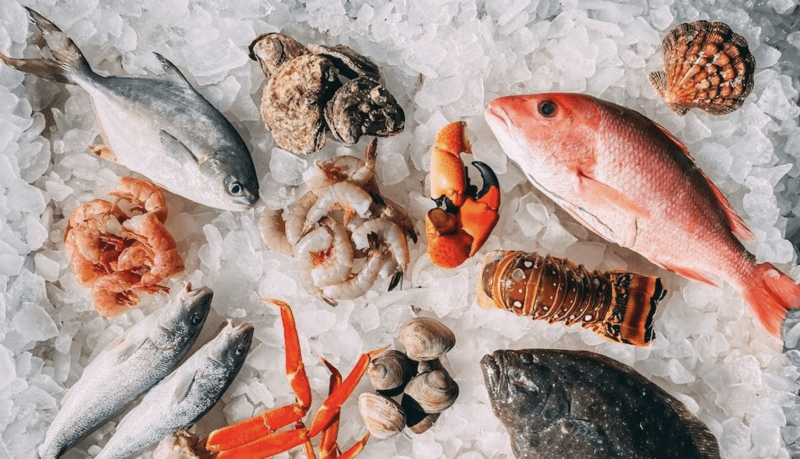6 Tips For Cooking Seafood At Home

Who doesn’t love seafood? First of all, it tastes great. And it is an excellent source of lean protein, omega-3 fatty acids, vitamins, and minerals.
However, cooking seafood at home can be intimidating for beginners. The delicate nature of seafood means it’s easy to overcook, resulting in a dry, rubbery texture. With improper handling, seafood is also more prone to contamination and foodborne illness.
Despite this, cooking seafood at home is doable with some basic knowledge. You just need a few simple tips on buying, prepping, and cooking to make restaurant-quality seafood dishes at home.
So, if you’re a home cook, here are some easy tips to help you cook delicious, healthy seafood meals at home.
1. Use Proper Cooking Methods
Choosing the right cooking method can make all the difference in maximizing the flavor and texture of seafood. Fattier fish like salmon, tuna, mackerel, and swordfish take well to pan-searing, broiling, baking, or grilling. The oil in these fish keeps them moist, so high-heat cooking gives a great caramelized exterior and tender interior. More delicate white fish like tilapia, cod, flounder, and snapper can be poached, pan-fried, or baked.
Shellfish like shrimp, scallops, clams, and mussels are best prepared by steaming, sautéing, or grilling briefly for just 1-2 minutes per side. It’s best to start with easier-to-handle produce like shrimps if you’re a beginner. You can try foolproofliving.com‘s shrimp skewers recipe to learn how to grill shrimp perfectly every time.
No matter the cooking method, always watch seafood carefully as it cooks to avoid overcooking.
2. Thaw Frozen Seafood Safely
If using frozen seafood, it’s crucial to thaw it properly to avoid foodborne illnesses. Don’t leave seafood out at room temperature to thaw. The exterior of the seafood could warm up to unsafe bacteria-growing temperatures while the inside remains frozen solid. Instead, the best way to safely thaw frozen seafood is to place it in the refrigerator overnight. Allow about 12 hours for a 1-pound package. Set the frozen seafood on a plate or in a container to catch any drips as it thaws.
For quicker thawing, place the frozen seafood still sealed in its original bag in a colander or bowl and run cold water over the bag. The cold running water will gently thaw the seafood without allowing the exterior to get too warm. An even faster method is to submerge the sealed bag of seafood in a large bowl of cold water. Change out the water every half hour until the seafood is pliable and thawed throughout.
3. Pat Dry and Season Lightly
Before cooking seafood, it’s important to pat fish and shellfish dry with clean paper towels. Any excess moisture left on the surface can cause steaming instead of getting a nice sear. The drier the surface, the easier it will brown.
Also, go easy on heavy seasoning to avoid overpowering the seafood with intense spices. A simple sprinkling of salt, pepper, fresh herbs like dill or parsley, and a squeeze of citrus or drizzle of olive oil allows the seafood flavor to shine.
4. Cook at High Heat for a Short Time
The key to cooking moist and flavorful seafood is using high heat for a short time. Pan-searing, grilling, or broiling the seafood over high heat helps develop the natural flavors and achieve the right texture.
Cook fish portions for just 2-5 minutes per side. Cooking it quickly prevents the delicate proteins from drying out, and the intense heat caramelizes the natural sugars in the fish, giving it a lovely browned crust.
Removing seafood from the heat a minute or two early is better because it will continue cooking from residual heat after you take it off the grill or out of the pan.
5. Use a Thermometer for Doneness
Seafood tends to overcook quickly, going from perfectly done to dry and rubbery in a matter of minutes. Using an instant-read food thermometer is the best way to prevent overcooking your seafood if you’re a beginner. For most fish like salmon, halibut, tuna, and cod, it is safely cooked through when the internal temperature reaches 145°F.
Shellfish have visible signs of doneness; clams, mussels, and oysters are finished cooking when their shells open up. However, you may want to discard any that don’t open. As for the shrimp, it will turn opaque and pink when cooked through fully, whereas scallops become opaque and milky white on the interior and should feel firm when pressed gently.
The thermometer takes away the guesswork of when seafood is at peak doneness for both taste and food safety. So, it’s best to invest in a good instant-read thermometer.
6. Let It Rest Before Serving
After cooking, it’s important to let seafood rest for 5-10 minutes before serving it. Similar to meat, letting seafood rest allows the juices inside to redistribute evenly throughout the flesh. The cooler interior equalizes in temperature with the hotter exterior, finishing the cooking process.
Conclusion
So, there you go. Cooking restaurant-quality seafood dishes at home IS possible for everyone. The first step is to choose good quality seafood and thaw frozen seafood safely. Before seasoning and cooking over high heat, pat fish and shellfish dry. Also, using the appropriate cooking methods for each type of seafood ensures it is perfectly cooked.
With these simple tips, home cooks can gain confidence in creating delicious seafood dishes.
______________________________________________________________________________
This is a contributed post